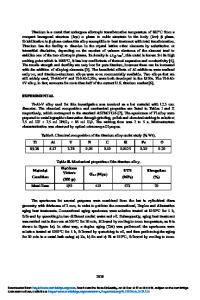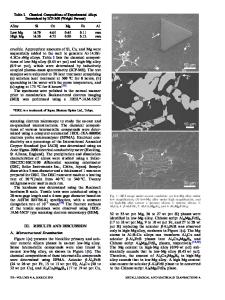The Effect of Iron Content on Microstructure and Mechanical Properties of A356 Cast Alloy
- PDF / 3,902,420 Bytes
- 11 Pages / 593.972 x 792 pts Page_size
- 28 Downloads / 380 Views
ION
AL-SI-MG alloys are engineering alloys which have mechanical properties that can be developed by addition of alloying elements; they find application areas especially in automotive and aerospace industries due to their good castability capabilities.[1] Microstructure and mechanical properties of cast aluminum alloys depend on various parameters such as chemical composition,[2] design of runner system,[3,4] oxide inclusion content,[5–7] filtration of liquid metal,[8,9] and rate of solidification.[10] One of the major defects that affect cast part performance is the presence of double oxide layers known as bifilms. Bifilms occur as a result of poor runner design which can cause porosity in cast metals, and thereby the mechanical properties decrease.[3,4] On the other hand, Wang et al.[5] reported that shrinkage porosity more adversely influences fatigue life than oxide bifilm defects in cast aluminum alloys. Dispinar and Campbell[6] reported that liquid metal quality in aluminum alloys are correlated with number and lengths of bifilms, and the highest ultimate tensile strength and elongation are obtained in melts with low bifilm index. It was also reported by Dispinar[6,7] that since bifilms initiate porosity, the decrease in the mechanical properties was more dominantly related with the bifilm index but not porosity. In the study of Tunc¸ay and O¨zyu¨rek,[8] it was reported that the use of ceramic foam filters was TANSEL TUNC¸AY and SAMET BAYOGLU are with the Department of Manunfacturing Engineering, Technology Faculty, Karabuk University, 78050 Karabuk, Turkey. Contact e-mail: [email protected] Manuscript submitted June 9, 2016. Article published online January 11, 2017. 794—VOLUME 48B, APRIL 2017
effective on mechanical properties and that as pore densities of ceramic foam filters increased, ultimate tensile strength and elongation values were increased. This is mainly due to the fact that bifilms are trapped in the filters. Another important factor that may influence mechanical properties of Al-Si-Mg alloys is hydrogen content of alloy. After the folding of surface oxide by turbulence and its entrainment in the liquid, bifilms start to unravel due to liquid/solid contraction during solidification, and depending on the hydrogen content, the size of the porosity may change. As Campbell[11] shows that low hydrogen leads to crack-like pore formation and high hydrogen will result in more spherical pores. As a result, the cast part may suffer from ductility when subjected to loads. Peres et al.[12] stated in their study that cooling rate in Al-Si cast alloy obtained with directional solidification is more effective on the distance between primary and secondary dendritic arms. Grain size of dendritic cells, intermetallic phases, and morphologies of the phases play significant role in mechanical properties of cast Al-Si-Mg alloys.[13] Wang and Davidson[14] revealed that Mg2Si precipitates increase during the aging process depending on the added Mg amount into Al-Si-Mg. It was also reported that in Sr-modified Al-Si-Mg alloys, at di
Data Loading...











